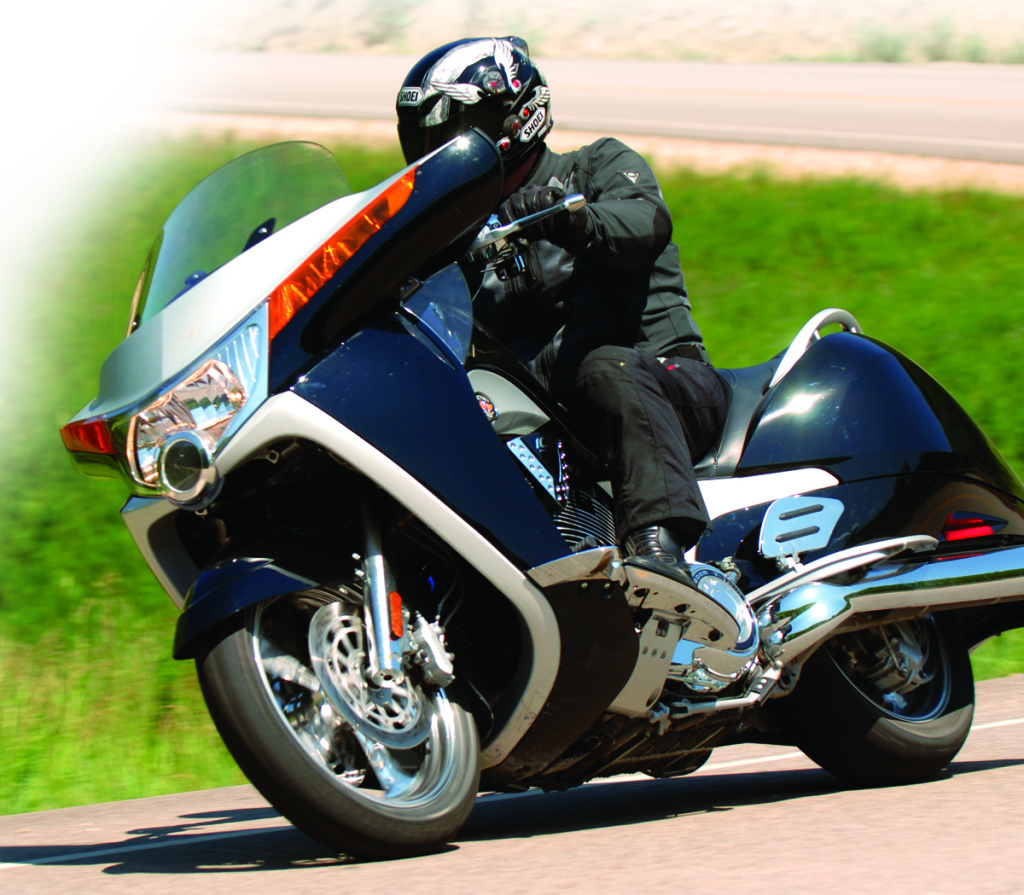
Victory Motorcycles is firmly, if not happily, in the black today, selling V-twin cruisers like its Vegas and Hammer series at a fairly brisk pace from a growing list of about 320 dealers in the USA. Getting there wasn’t easy, after missteps like its sincere but plain-looking initial V92C model in 1999 then attempting to please some of the press rather than the market with the oxymoronic Sport Cruiser. It wasn’t until 2002–with a new CEO at the helm–when the Freedom V92 engine was introduced with extensive improvements and then the sleek Vegas with its Ness-inspired lines appeared in 2003, that things finally started looking up for Victory.
Still, there had to be a pregnant pause when, in January 2004–the division of Polaris Industries no longer sinking but still losing money–Victory decided to make its single largest investment to date…on the Vision before you. The result is the most controversial and unique-looking production motorcycle to come along in years, with styling that is either love it or hate it. The Vision also makes several technological leaps such as an aluminum frame and CAN-Bus electronics not unproven, but previously unknown to the elemental cruiser company. It’s a swooping fantasy of a traditional V-twin touring bike aimed at riders who tend to embrace the contemporary (BMW K1200LT, Honda Gold Wing) as well as those who want heritage with convenience and comfort (Harley-Davidson Ultra Classic Electra Glide).
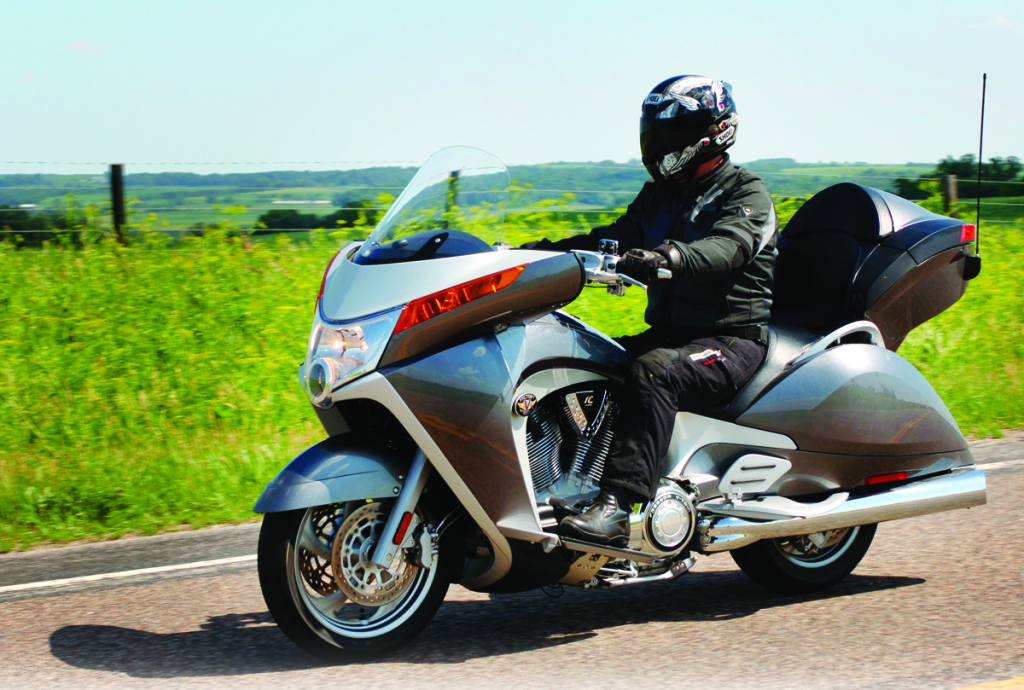
“We wanted to create a very polarizing bike that half the room absolutely loved and absolutely had to have,” said Gary Gray, Product Manager, speaking of focus groups who were shown Vision conceptions in the early going. If photos of the bike have you siding with the other half of the room as I did, know that the Victory Vision must be seen in person to be appreciated, and then ridden to be convinced…that Victory is not only not nuts, but really on to something.
Ride it we did, too, more than 500 miles in Minnesota, Wisconsin and Iowa at the bike’s recent official launch. I came away thoroughly impressed with the Vision’s potential, too, though full test results will have to wait until Victory will part with a test bike for us to ride more, weigh and put on the dyno. Average fuel economy figures are on hold, too, until we can get a Vision and ride it like you would, rather than hard on the gas for a day-and-a-half among the city of Minneapolis, Victory’s New Product Development Center in Wyoming, Minnesota, and its Spirit Lake, Iowa, assembly plant.
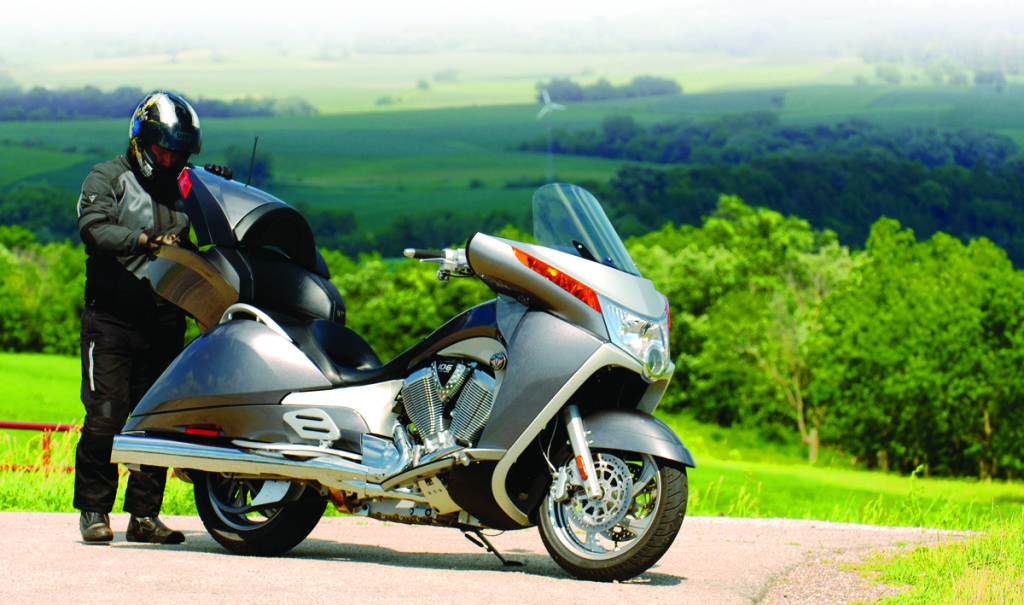
At the latter facility we got to see the birth of not just several Visions but Vegas and Hammer models on Victory’s mixed-model assembly line, which it says allows the most flexibility and adaptability to demand. Engines fresh from Victory’s Osceola, Wisconsin, assembly plant are loaded on the line at Spirit Lake and the rest of the matching bike assembled around them, starting in the Vision’s case with its cast-aluminum hollow main frame, which suspends the V-twin as a stressed member and serves as its airbox. The simplified, two-piece truss design also has a cast-aluminum seat subframe-floorboards, foot controls and the cast-aluminum swingarm are all mounted on the engine.
The Vision’s engine is based upon the Freedom 100 six-speed but has refinements galore and a longer stroke (108mm vs. 102) giving it 106ci (1,731cc) and making it essentially an all-new powertrain. Victory rates it at 92 horsepower at 4,500 rpm and 109 lb-ft of torque at 3,250, nice numbers for a two-up cruiser-touring bike with a claimed dry weight of 809 pounds for the Street model and 849 for the Tour (with top trunk and passenger backrest). As with all 2008 Victorys, much attention was paid to reducing NVH-noise, vibration and harshness-in the new Vision mill, with refinements such as stepped bushingless connecting-rod small ends (that reduce reciprocating weight), a split primary gear on the clutch and a stiffer and restyled primary cover (both for less noise). There’s also a quieter alternator in addition to the Freedom’s primary counterbalancer. Victory says there’s no increase in vibes from the engine, in fact, despite the longer stroke.
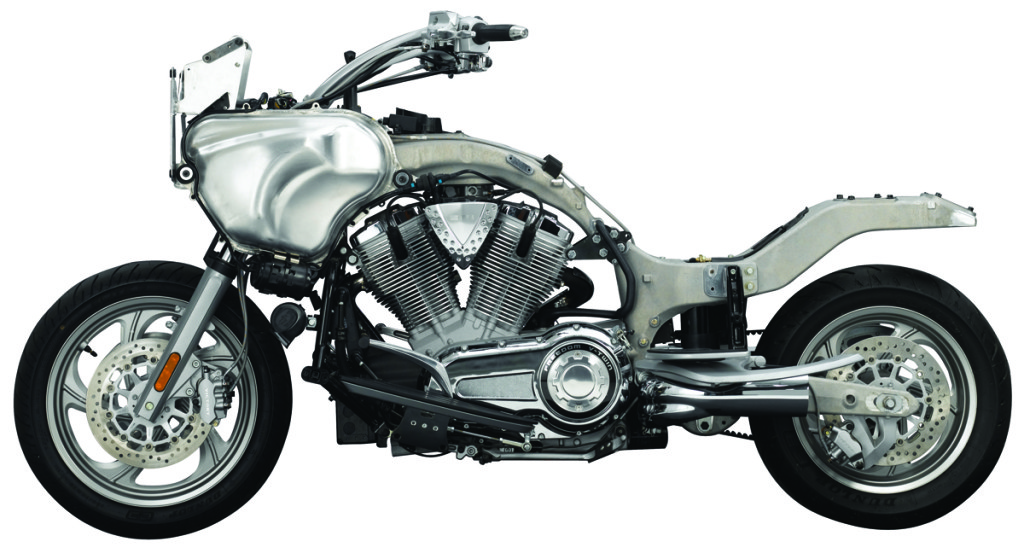
Although valve sizes in the SOHC, 4-valve-per-cylinder engine remain the same, more displacement means more heat to home in on the narrow bridge of metal between the exhaust valves. So, although essentially an air-cooled engine, that bridge gets pinpoint cooling in the heads from oil circulated through a small cooler on the front of the bike. In addition to fully sequential, closed-loop EFI (with a catalyzer in California), the Vision also has hidden within its engine what-at 50 amps-may be the highest-output crank-speed alternator. “Tip-in” (or throttle abruptness), was avoided with special throttle body linkage as well as careful spark calibration. Finally, the top sixth gear (Victory calls it overdrive) ratio has been increased over the Freedom 100’s for lower cruising rpm, and first gear is lower for better low-speed rideability and acceleration. Power is moved rearward via a clean, low-maintenance belt final drive.
Even with all of these powertrain improvements, Victory is quick to say that its priorities on the Vision were style and comfort. Despite 4 inches of padding in the rider’s seat, it’s just 26.5 inches high, and narrow at the front for easy stops. The tall, long handle- bars are vibration-isolated, and floorboards reach from just ahead of the rider all the way to the front of the engine, so that even the tallest rider can stretch his or her legs all the way out. The shift lever and brake pedal have three-position adjustment fore-and-aft as well as the usual up-and-down with their threaded actuation shafts, and the passenger floorboards can be raised with optional pedestals. Adjustable wind deflectors allow more or less airflow to hit the rider, and 60-plus factory options include both taller and lower windscreens in addition to the electrically adjustable one available in Premium model packages.
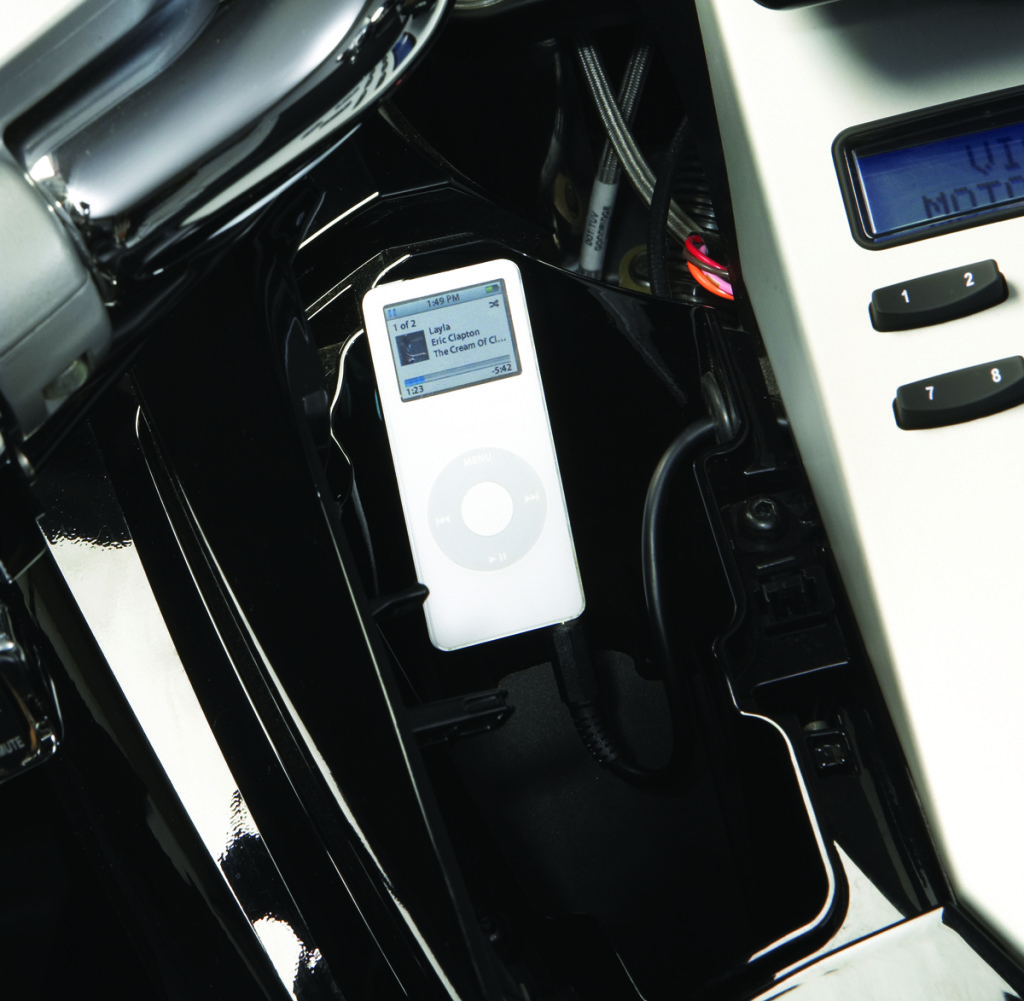
For your audio-visual entertainment the Vision’s standard AM/FM sound system with four speakers is programmed to integrate and control options such as an iPod in the left fairing pocket, CD changer (in the Tour’s trunk), headset intercom and CB radio, all of which will appear on the LCD display when connected. An optional Victory/Garmin GPS with voice can also be set up to chime in with voice directions over all of the other sound devices.
I was able to sample several different Vision Street and Tour models on this ride, with varying levels of equipment from stripped to fully loaded. Among all of the bells and whistles I found none that performed unsatisfactorily, and several that worked very well, including the sound system with iPod integration, electric windscreen and GPS. It was a bit too warm to sample the heated grips and seats, and we didn’t ride at night so testing the halogen and HID lighting will have to wait for the full test as well.
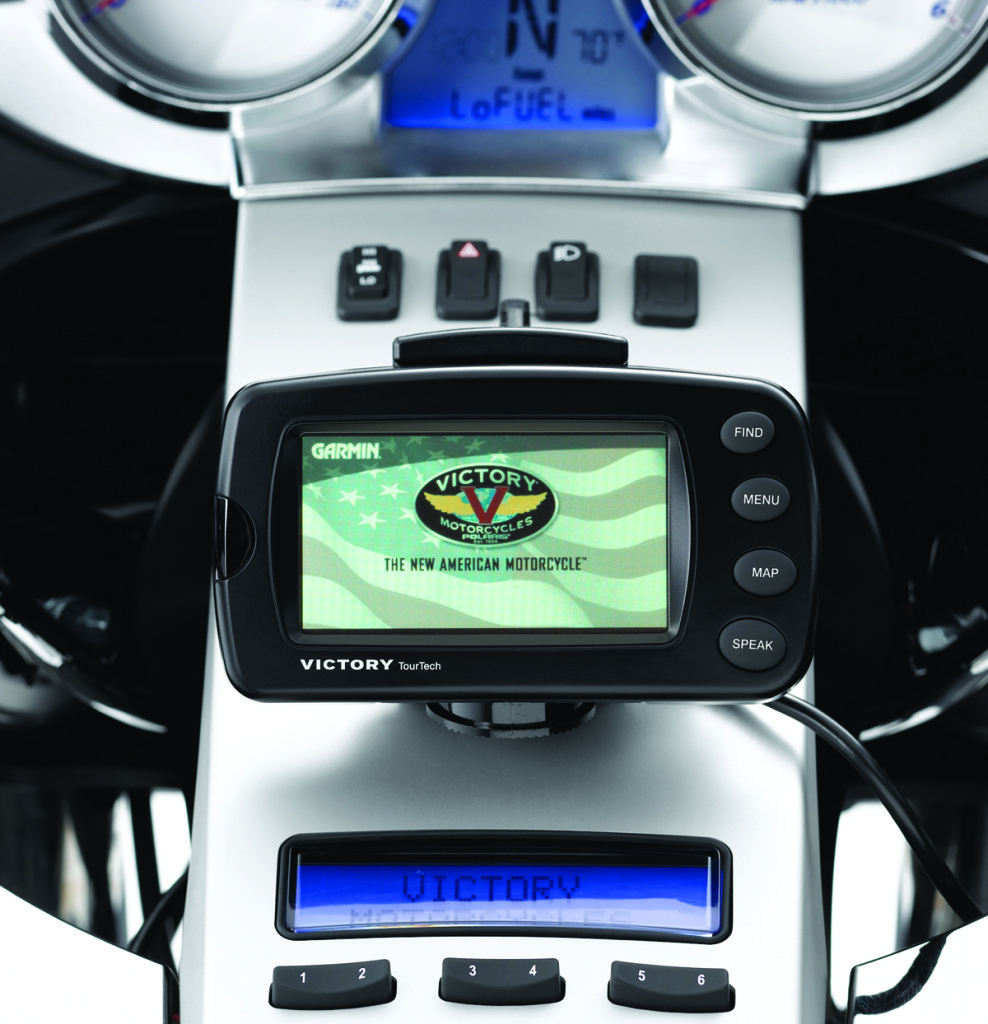
Vision basics are all impressive, the makings of a fine touring machine, from power delivery and sound to handling and braking. Engine power is always at hand without much shifting, and redline is high enough at 5,200 rpm that even when accelerating hard you don’t hit it prematurely between shifts, though power output flattens at just 4,500 rpm. Although the mirrors shake most of the time the bike is comfortably smooth, with a lively pulse feel and sound, and quick passes are cake with a twist of the throttle, maybe a downshift into fourth or fifth since the bike is turning just 2,650 rpm at 70 mph in top gear. I wouldn’t mind less airbox noise in the cockpit-the better to hear the sound system-and the engine does put out quite a bit of heat that bakes your legs when underway. Big engine = big power = heat, that’s all there is to it, though it’s less noticeable stopped at idle as your legs are well away from it. As with any fully faired motorcycle various mechanical sounds are reflected back to the rider, but two of these early production Vision models that I rode had more than their share, producing an oscillating whine on decel that one engineer pegged as a misaligned belt drive. It sounded more like gear whine to me, but in either case shouldn’t be present in models delivered to dealers in fall 2007.
We managed to find a few corners among Red Wing, Rollingstone and Rushford, Minnesota, and I found the big Vision a pleasant surprise here. Although it steers somewhat slowly it has much more cornering clearance than you might expect, and holds a line quite well on its Dunlop Elite 3s (which, on one bike we were shown, still had tread left after 11,000 miles). Braking is linear and strong from both the adjustable front lever and rear pedal, the latter of which also partially actuates each of the three-piston calipers up front under moderate-to-heavy braking. I liked that the front lever brakes just the front, which makes adjusting your speed around town or in corners more predictable. Victory will not offer ABS on the Vision to start as it wasn’t high on its customers’ wish lists, though it may come later.
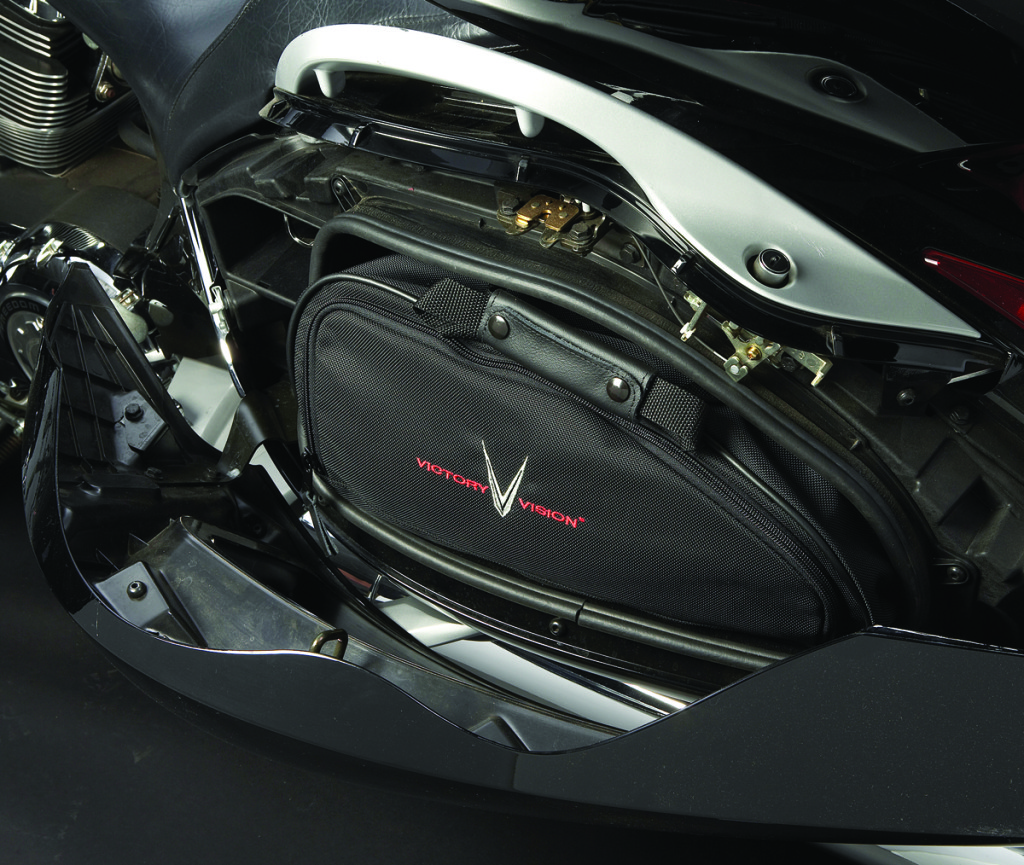
Suspension on the Vision is simple and straightforward, with a conventional telescopic fork up front and air adjustable, coil-spring shock in back that has an easily accessed Schrader valve. To save space under the seat (for more foam!) Victory uses a rising-rate linkage system for the shock that compresses it from both ends. The bike has a nice ride, seems to soak up the bumps and handles corners well, but I’ll especially reserve judgment here until we can load one up, change pressures and hit a wider variety of road types…and more corners.
On the highway the Vision is a peach, with good, quiet wind protection from the electric windscreen (shorter fixed ones buffet more), excellent comfort all around and rock steadiness at speed on the Street model. I noticed some twitchiness on the trunk-equipped Tour model, possibly from the crosswinds we had much of the time, but it wasn’t a real bother. We spent most of our time on the highway super-sizing the speed limit, so I suspect that at more modest velocities the bike will be even more pleasant. The rider’s seat is cushy-I liked it even on the longest, warmest day-and those long floorboards are an innovation every luxo-tourer should have. Range from the six-gallon fuel tank should be excellent, though filling it up takes a while as it’s split in half and connected with an equalizing hose.
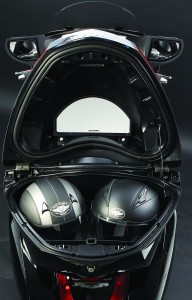
Despite the size of those arcing side pods in back the locking saddlebags are actually quite small in capacity-each is easily filled with the standard toolkit, a large rainsuit, a small water bottle and a light sweater. The trunk on the Tour model (removable in about 10 minutes, says Victory, and retrofittable to the Street) does hold two full-face lids without the CD changer installed. Victory spent quite a bit of time ensuring the bags seal well, so at a minimum we’ll give them the hose test during the full review. Integrated tipover protection on the Vision front and rear allows the bike to fall over only 30-40 degrees on a flat surface and keeps the bike’s Black, Super Steel Gray or Midnight Cherry paint and appearance parts from harm. I got to watch it in action when a rider tipped his bike over making a U-turn, and it worked just as promised.
The Vision is a huge investment and commitment on Victory’s part to the heavyweight touring market, one which has had its share of attrition in recent years. Certain models with the right appeal are enjoying steady if not brisk sales, though, and if the Victory Vision’s styling wins over half of those-heck, even a quarter-it will be a smash success, because I believe its performance is even better. Stay tuned for more in future issues.







